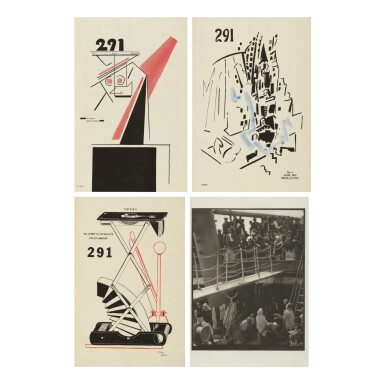Alfred Stieglitz, Georgia O’Keeffe, Juan Hamilton: Passage
Alfred Stieglitz, Georgia O’Keeffe, Juan Hamilton: Passage

ALFRED STIEGLITZ, EDITOR | '291'
Auction Closed
March 5, 05:19 PM GMT
Estimate
30,000 - 50,000 USD
Lot Details
Description
ALFRED STIEGLITZ, EDITOR
1864 - 1946
'291'
(New York: Published by 291, 291 Fifth Avenue, New York, N. Y., March 1915 - February 1916), 2 complete series of 12 Numbers in 9 issues (one deluxe, one regular), each comprising Nos. 1, 2, 3, 4, 5/6, 7/8, 9, 10/11, and 12, illustrated with reproductions of artwork and typographical compositions by Francis Picabia, John Marin, Pablo Picasso, Maurice de Zayas, and others, some with hand-coloring, and each including the large-format photogravure of Alfred Stieglitz's The Steerage, one printed on thin Japanese paper (deluxe set) and the other on Japanese vellum (regular set), inserted in Nos. 7/8 as issued; each set together with a single folio sheet announcing the opening of the Modern Gallery, inserted in No. 9 as issued; 10 individual wrappers, and one outer wrapper, initialed AS., titled "291", dated March 2/1917., inscribed To Georgia O'Keeffe, and annotated One of twelve complete sets like this in Stieglitz's hand in pencil. Folio, possibly original red folding portfolio case
The issues various sizes to: 19 by 12 ⅝ inches
(48.3 by 32.1 cm)
Executed in 1915-16.
Alfred Stieglitz, New York
Gift of the above to Georgia O’Keeffe, 1917
By descent to the present owner
Complete sets of '291' seldom come to market and it is believed that no other double set of '291' has appeared at auction. The lot offered here includes two complete sets, both the regular and the deluxe editions. Stieglitz’s annotation on the wrapper ‘One of twelve complete sets like this’ indicates that intact double sets such as this are exceedingly rare.
In January 1915, Paul Haviland and Marius de Zayas visited Alfred Stieglitz at his gallery, 291: ‘We and Agnes Meyer feel that 291 is in a rut. The war has put a damper on everything. We must do something. We have the idea that 291 should publish a monthly magazine devoted to the most modern art and to satire, presented in a spirit related to some of the most modern publications in France’ (Dorothy Norman, “Four Happenings: The Magazine ‘291’ and ‘The Steerage’,” Twice a Year 8/9 (Spring/Summer–Fall/Winter 1942, p. 131). Stieglitz agreed to this idea, along with the proposal that the publication be named after his gallery, and the foursome proceeded with the new project. The proto-Dada publication ‘291’ was entirely different in format from ‘Camera Work’ (see Lot 42) or any other existing periodical. Several of the issues were hand-colored, rendering them inherently unique, and making the publication an artwork in itself. With the first issue published in March 1915, ‘291’ would eventually consist of twelve numbers in all (six single issues and three double issues) and was available in both a ‘regular’ edition, printed on thick paper, and a ‘deluxe’ edition, printed on Japanese vellum.
One double issue (Nos. 7/8, September/October 1915) was devoted to photography and included a photogravure of Stieglitz’s renowned image The Steerage (1907). Under Stieglitz’s supervision, five hundred photogravure proofs were pulled on Imperial Japan paper for the regular edition and a smaller edition was pulled on thin Japan tissue for the special deluxe edition. The regular edition was available for $2 dollars and the price of the deluxe edition was available on request. Given the positive feedback he had received about this photograph, Stieglitz was confident that many people would subscribe to ‘291’ in order to have their very own copy of The Steerage. Not much was done to attract subscribers, and Stieglitz and his collaborators had overestimated wartime demand for such a publication: about 100 people subscribed to the regular edition and only 8 to the deluxe edition. In a final satirical gesture, Stieglitz sold the remaining 8,000 or so copies of the regular edition in 1917 to a rag picker for $5.80; he kept the deluxe copies but eventually destroyed most of them.
